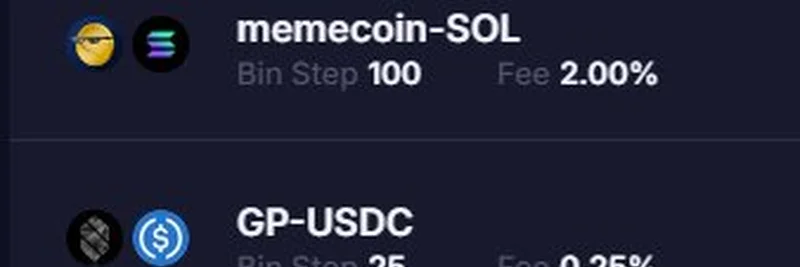Hey there, meme coin enthusiasts! If you’ve been keeping an eye on the latest trends in the crypto world, you might have stumbled upon an intriguing X post from kuanlee on July 23, 2025. This tweet showcases a fresh strategy involving multi-layered 20bins pools for two exciting tokens: GP and Ani-SOL. Let’s break it down and see what this means for the future of meme coins!
What Are Multi-Layered 20Bins Pools?
First things first, let’s unpack the concept. A "20bins pool" refers to a liquidity pool divided into 20 price ranges (or "bins") where traders can swap tokens. These pools are a part of decentralized exchanges (DEXs) and help ensure there’s enough liquidity—basically, the cash flow—for trading without massive price swings. Kuanlee’s twist? Adding multiple layers to these pools, which could mean stacking different price ranges or combining various tokens to create a more dynamic trading environment.
In the images shared, you can see pools for tokens like MOMO-SOL, memecoin-SOL, GP-USDC, and Ani-SOL, each with different "Bin Step" sizes (e.g., 250, 100, 25, 20) and fee structures (ranging from 0.20% to 2.00%). The multi-layered approach seems to fine-tune these settings for better efficiency.
Diving Into the Data
The second and third images give us a peek at the price ranges and liquidity details. For GP-USDC, the price ranges like 4.0235-4.435 USDC per GP show a 24-hour fee TVL (Total Value Locked) of 6.23% and a liquidity of $115.19. Meanwhile, Ani-SOL lists price ranges in tiny SOL increments (e.g., 0.00034862-0.00036678 SOL per Ani), with a liquidity of $37.57. These numbers suggest Kuanlee is experimenting with tight price bands to attract traders while managing risk.
The varying fee percentages (e.g., 0.25% for GP-USDC vs. 2.00% for MOMO-SOL) indicate a tailored strategy. Lower fees might encourage more trading volume, while higher fees could be a buffer for volatile meme coins. It’s a balancing act that could redefine how liquidity pools operate!
Why This Matters for Meme Coins
Meme coins like GP (from the Graphite Protocol) and Ani-SOL thrive on community hype and innovative mechanics. By using multi-layered 20bins pools, Kuanlee is potentially making these tokens more accessible and stable for traders. This approach could:
- Boost Liquidity: Smaller bin steps (e.g., 20 or 25) allow for finer price adjustments, attracting more participants.
- Reduce Volatility: Layering pools might smooth out wild price swings, a common issue with meme coins.
- Encourage Experimentation: This setup invites other developers to test similar strategies, pushing the boundaries of decentralized finance (DeFi).
What’s Next for GP and Ani?
Kuanlee’s experiment is a exciting step forward, especially as we head deeper into 2025. The GP token, tied to the Graphite Protocol, aims to simplify Web3 project launches, while Ani-SOL seems to be a Solana-based meme coin riding the wave of community-driven tokens. If this multi-layered approach proves successful, we might see more projects adopt it to enhance their trading ecosystems.
For now, keep an eye on meme-insider.com for the latest updates on this trend. We’ll be tracking how these pools perform and whether they inspire a new wave of meme coin innovations. Got thoughts on this strategy? Drop them in the comments below—we’d love to hear from you!



